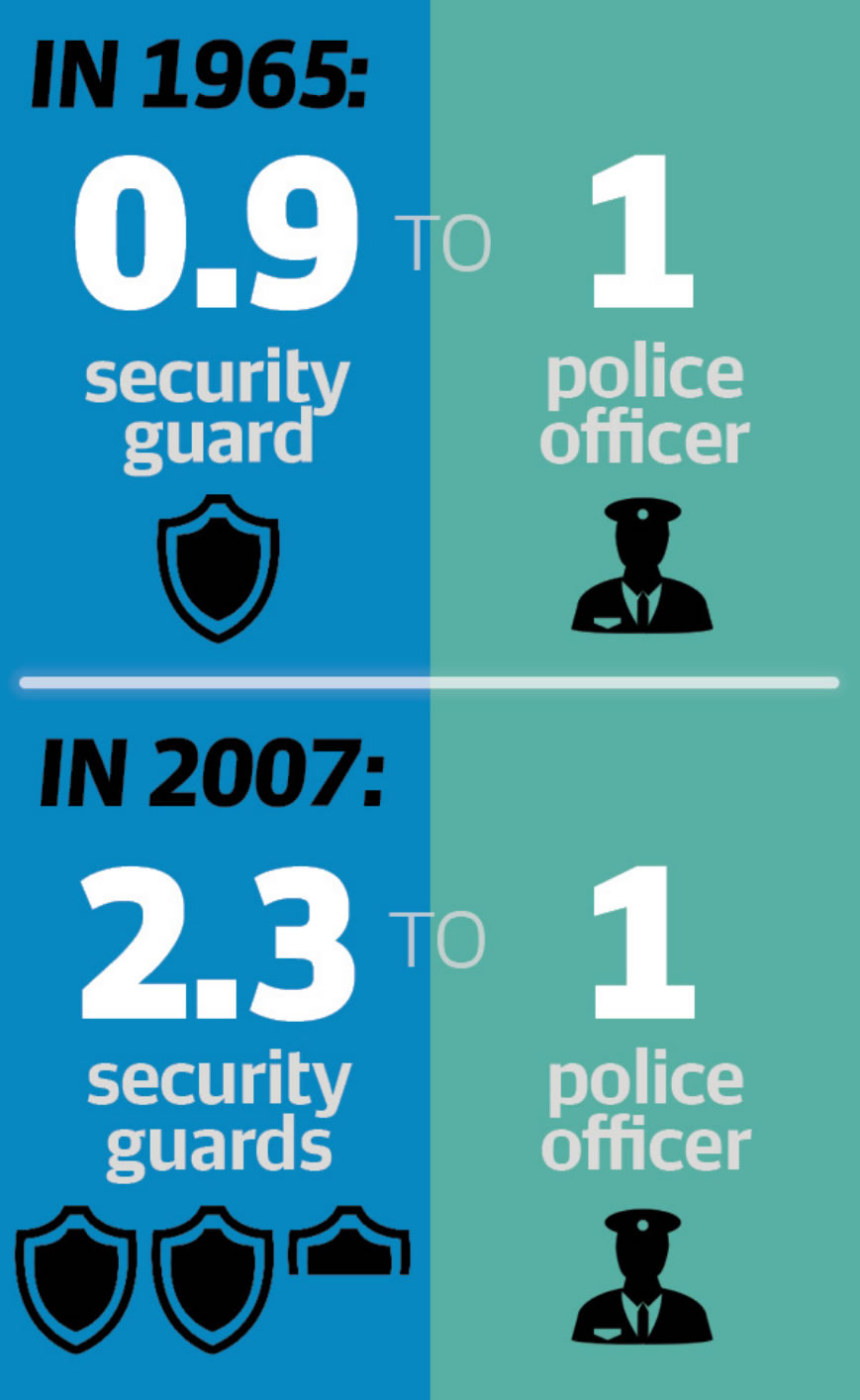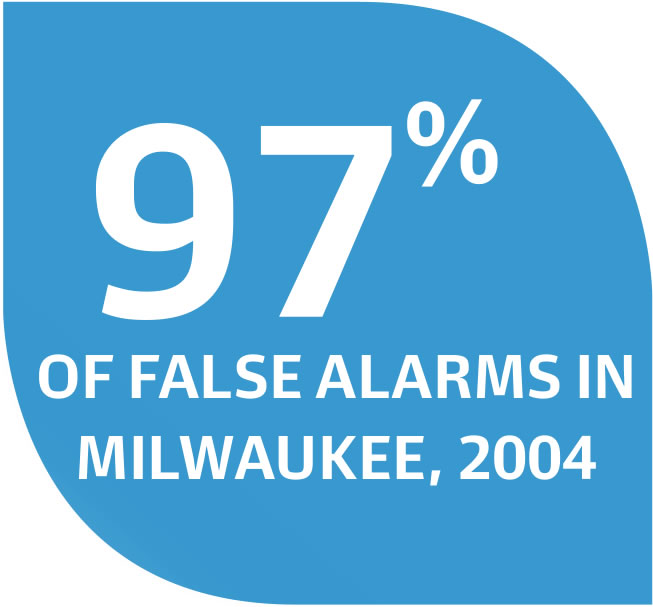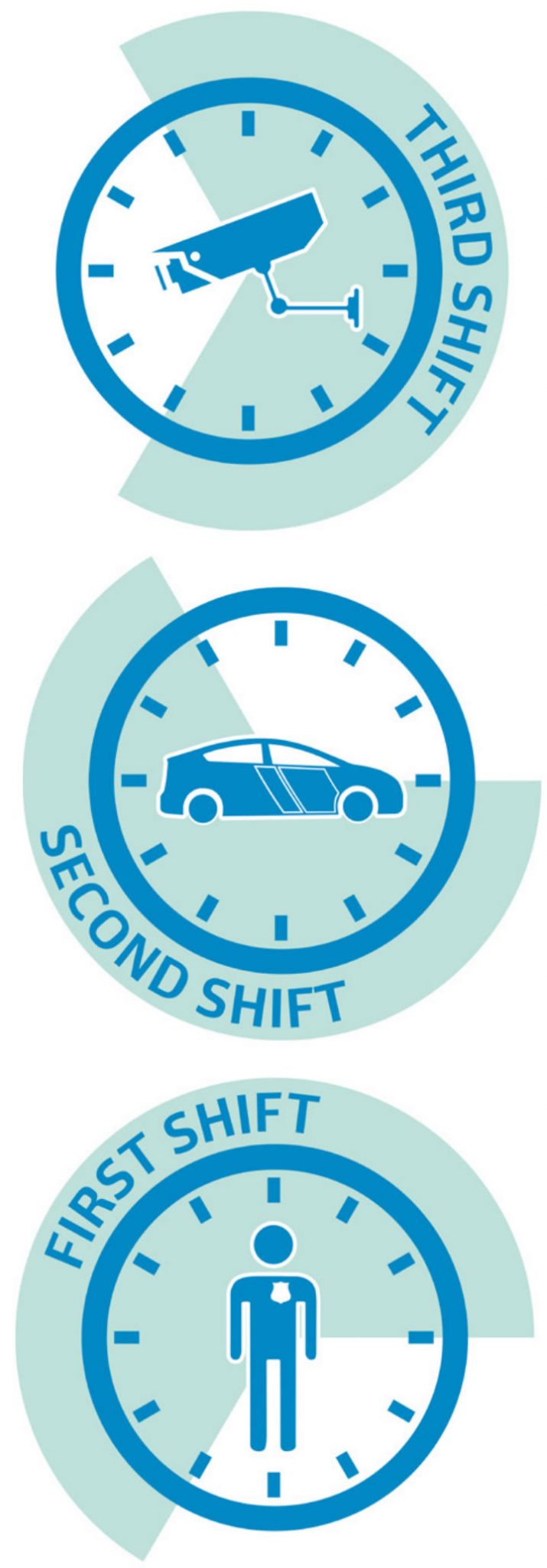Even before the “Great Recession” of 2008-2009, law enforcement budgets were stretched thin. From Los Angeles and San Francisco to Las Vegas and Sacramento, many municipal police departments were obliged to institute hiring freezes or reduce the number of sworn officers.
Despite these budget and labor constraints, however, law enforcement is being asked to assume even more responsibility for public safety and security. For example, in the wake of the September 11, 2001 terrorist attacks, some police are now tasked with securing vital infrastructure such as train stations, bridges, power plants, and more.
As a consequence of providing more services with fewer resources:
- Average response times by police have increased.
- Local governments have levied (or increased) fines on businesses and homeowners
whenever police respond to false security alarms. - A growing number of towns and cities, including Las Vegas and Milwaukee, have insti-
tuted Verified Alarm Response (VAR) policies. Accordingly, the police no longer respond
to alarms unless video or eyewitness corroboration is first provided that an actual crime
is in progress. - Increasingly, businesses and homeowners are employing private security firms to patrol
their neighborhoods. In Chicago, Milwaukee, New Orleans and New York, for example,
the members of “business improvement districts” have pooled resources to hire private
security officers. These officers patrol the streets, respond to alarms, interact with busi-
ness owners, and serve as a supplemental deterrent to crime.

Collectively, these and other smaller trends are fueling a larger trend toward the privatization of certain security and policing functions. In 1965 there was one sworn police officer for every 0.9 private security guards in the U.S. By 2007, 2.3 private security officers were employed for
every sworn officer, and the number of private security personnel has only grown since then. ii By the mid-1990s, one retailer even employed more security officers than there were police officers in the entire Los Angeles police department.
Since 9-11, the public and private sectors have sought new and better ways to promote cooperation to improve public safety and control costs. Although the decades-long privatization trend is cause for concern by some observers, most experts believe “the great contemporary challenge confronting public safety in the United States is not primarily about whether privatization and civilianization are good things … but about how best to serve the public’s need for protection against crime….
indeed, few policy experts advocate the wholesale substitution of private security for sworn police. Instead, most believe the lion’s share of policing, including criminal investigation and apprehension, should remain the sole domain of the public sector. At the same time, there is widespread agreement that certain time-consuming (and largely ancillary) functions are more cost-effectively handled by the private sector, and that privatization of these tasks benefits the
public by allowing law enforcement to devote more time, manpower and equipment to higher-priority tasks.
A Good Fit for Privatization
From a public policy perspective, expecting police to respond to unverified security alarms is an unnecessary consumption of taxpayer dollars and law enforcement resources. In the United States in 2002, police responded to approximately 36 million alarm activations at an estimated
cost of $1.8 billion. In fact, the vast majority of the calls – between 94 and 98 percent (higher in some jurisdictions) – were false. Research suggests that the most common causes of false alarms are:
- User errors – e.g., typing incorrect keypad codes, leaving doors or windows open when
activating alarms, pets, and inadequate employee training. - Faulty or inappropriately selected equipment.
- Poor installation, including failure to install motion detectors in “sensible” areas or at
appropriate heights.
Conversely, a recent survey of VAR policies across 20 U.S. jurisdictions revealed that the police enjoyed significant time and manpower savings after such policies were implemented.Before Milwaukee instituted a VAR policy in 2004, police responded to 30,000 burglar alarms per year – 97 percent of which were false. Annually, false alarms in Milwaukee consumed the time of up to 150 police at a cost of over $1.1 million. In 2012, by contrast, the number of alarms to which Milwaukee police responded dropped to 620 – only 38 percent of which were fasle.

Salt Lake City’s VAR policy reduced police response times to high-priority emergency calls by an average of two minutes, and nearly 8,500 officer hours were freed for other priorities. In fact, every municipality surveyed reported significant time savings for police as well as an increased ability to respond promptly to emergency calls.
Answering the Alarms
Today it’s easier than ever to remotely detect potential security issues. Consumers can walk into a Home Depot or a Best Buy, and walk out with security systems that are less expensive, more user-friendly and more sophisticated than anything available 15-20 years ago. But if these
alarms activate, who will respond to them, and what will the responders do upon arrival, especially if they encounter a crime in progress? While police are authorized and trained to detain and interrogate criminal suspects, most private security officers are not.
In short, what are the direct costs and benefits to homeowners and businesses of privatizing alarm response?
Until recently, alarm systems were often connected directly to police stations. Today, that’s rarely an option. Increasingly, the only personnel willing and able to respond to alarms are the security officers employed by alarm companies or the consumers themselves.
At larger businesses, security officers may be hired to patrol properties 24/7 or cover particular shifts, maintaining a physical on-site presence for all or part of each day. The problem with staffing an office building, manufacturing facility or distribution center with security personnel
for eight, 16 or even 24 hours is, of course, the significant cost of the labor. Staffing a location or multiple locations with private officers is beyond the financial means of many small businesses, and the routine nature of some security patrols tends to diminish their value as a crime deterrent.
Mobile Guarding and Alarm Response
A newer alternative to stationing security officers throughout a property is Mobile Guarding Alarm Response – an option that can dramatically reduce the cost of hiring private security while simultaneously increasing its efficiency and deterrence value.
Thirty years ago, a company leasing a 15-story office building might have hired multiple security officers to staff the property in two or even three shifts. In recent years, however, management might have determined that the rising cost of this arrange ment outweighed the risks.
ment outweighed the risks.
Thanks to advances in technology, specially-trained officers can now keep this company’s facilities under close and constant observation from offsite monitoring stations – at a fraction of the cost. The remote stations allow security personnel to position and reposition surveillance cameras, make announcements and summon emergency responders in the event of break-ins, vandalism, fire, flooding, accidents, etc.
Meanwhile, security officers in marked cars inspect customer facilities at random intervals throughout the day and night, remaining in the vicinity at all times so they can quickly respond to a variety of issues. (This is known as Proactive Patrolling.) In the case of a legitimate security breach or other perceived threat, officers staffing the off-site monitoring stations contact the appropriate responders, whether mobile security officers, law enforcement or other emergency personnel.
Remote surveillance also allows officers at the monitoring centers to identify and deactivate false alarms quickly. This saves customers money on false alarm fees, and helps maintain excellent relationships with local law-enforcement and other emergency responders. Advances in video analytics help security firms to recognize triggers and alert off-site monitoring personnel to the potential for false alarms before they become problems.
Other benefits of Mobile Guarding and Alarm Response include:
- Equipment and materials monitoring: Many manufacturing plants contain machinery or materials that must be kept at specific temperatures. Mobile security officers can check in, as needed, to confirm that these temperature (and other) specifications are met, and can even be trained to make minor adjustments.
- Real-time reports: Advances in technology mean that mobile officers can create reports on-site, alerting business owners to any security issues within minutes of detection. In-
stead of arriving at the location to find a problem, customers arrive to a complete review of the night’s activity. - Shift coverage: Mobile officers can provide a friendly face and peace of mind for employees working solo shifts, especially during overnight hours. They can be posted at a front
desk or lobby reception to cover employee breaks and provide parking lot escorts. - Power outages: In the event of a local or regional power outage, mobile officers will be alerted, and back-up officers dispatched to provide coverage at customers’ facilities.
Together, remote monitoring, alarm response, and proactive patrolling reduce the overall cost of security, including the cost of false alarms, while enhancing deterrence and helping to ensure rapid response to genuine threats and emergencies.

A Scalable Solution
The mobile guarding approach is also highly scalable. What works for a single location can work for multiple locations – even entire neighborhoods. Where officers once had to be physically present at control booths or entrances to gated communities, they can now monitor remotely. This is already standard practice for many larger companies whose manufacturing plants in the Northeast can be monitored by highly-trained personnel in the mid-Atlantic, from which security officers can dispatch local responders almost instantly.
Although a combination of remote and mobile guarding seems like an obvious solution for low-activity posts, it’s also a viable option for locations experiencing high levels of activity. Working with homeowners’ associations, security personnel can patrol entire neighborhoods during designated times. In addition to deterrence, they can help to promote neighborhood rules and guidelines, help keep pools, parks and playgrounds secure after hours, and enforce traffic regulations and more. Mobile units are a good value for these associations, since officers are not paid to staff a gatehouse or patrol 24/7, but patrol only at random intervals. Customers pay for only the proactive services they actually receive rather than for general “coverage.”
In business improvement districts, mobile security can serve as an extra set of eyes and ears for the police, helping deter minor nuisances (littering, loud music, loitering) that can erode merchants’ ability to do business.
New Avenues for Security
More than ever, both the public and private sectors are challenged by seemingly contradictory goals – to increase the security of people and property and maintain (or reduce) the associated expenses. These expenses, which include wages, benefits, taxes, fees and fines, are unlikely to abate and will probably increase over the long term. It’s reasonable to expect, therefore, that costs affecting the security industry will continue to rise even as many customers are under intense pressure to contain overhead and operate more cost-effectively.
This is where remote monitoring and mobile guarding alarm response can make a difference. The mobile monitoring and alarm response model allows commercial and residential property owners to enhance security while decreasing dependence on labor-intensive practices. Instead of simply employing more officers to provide more services, the best security firms deploy new technologies, tools and strategies to make each officer more productive.
